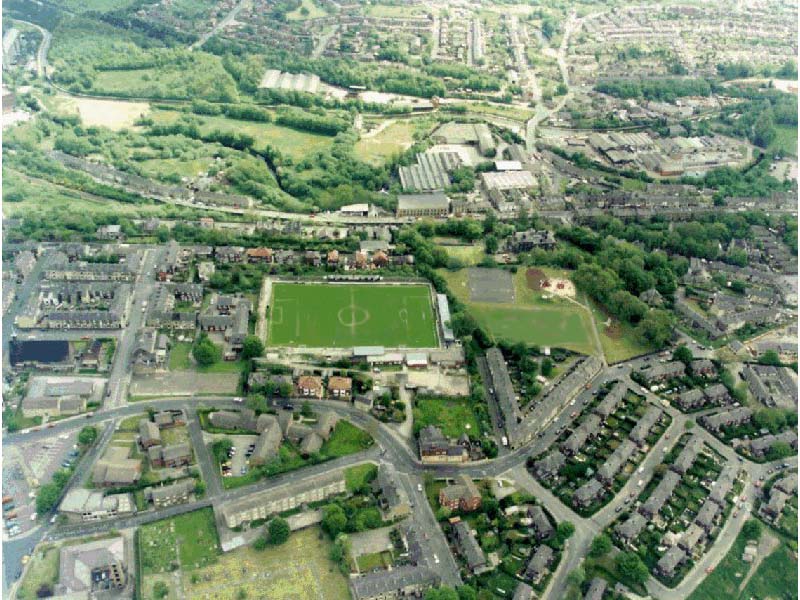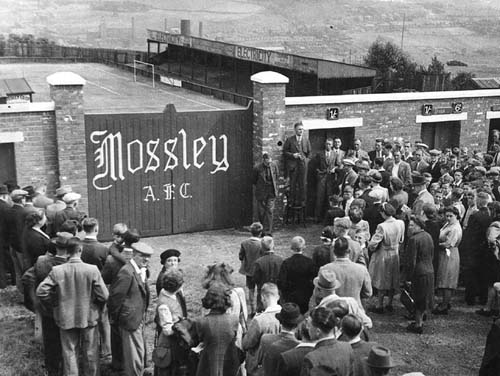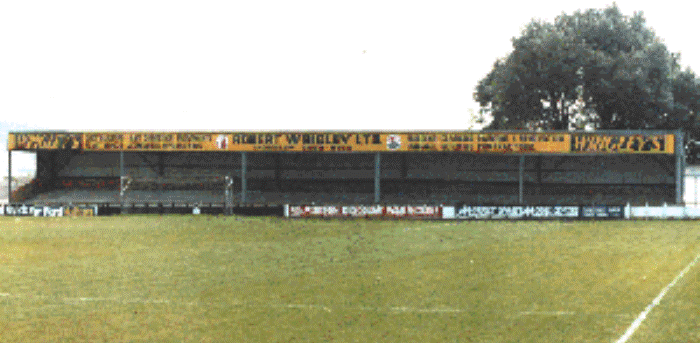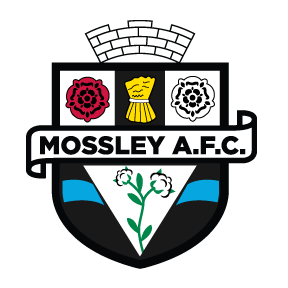
Prior to 1911, Seel Park (as we now know it) was a disused cricket ground and the site of a former tip.
In 1911, Mossley FC moved from Luzley to our new home, then known as Seel Fold, with headquarters in the Highland Laddie Hotel next to ground. Mossley’s first ever game at Seel Fold took place on Saturday 23rd September 1911 when Mossley beat Stalybridge St Peters 4-0 in the Ashton & District League.In 1912, work was undertaken at the ground to partly enclose it with a wooden fence.
A stand to hold 430 people was erected on the site of the former tip on the popular side by J.S.Adams Ltd. who also erected dressing rooms at the ground. The work was undertaken in 1920.
Our first ever turnstiles were erected in 1921 and the following year, wooden ‘sleeper’ terracing was built on main stand side.
More work was carroed out in 1927 as three new bays were added to the popular side stand which would now shelter 1,000 spectators. Mossley Co-operative Society erected refreshment buildings at Seel Fold.
Seel Fold was renamed in 1931 as Seel Park as the name was deemed to be more modern. The following year, in 1932, a new stand was erected at the Park End
A new main stand to seat 300 on the Market Street side of Seel Park was built in 1936.
Concrete walls around the pitch perimeter were constructed in 1947 as well as new terracing around the ground.
Mossley AFC bought Seel Park outright from owners ‘Stamford Estates’ for £1,200 in 1948. Concrete terracing was then erected in front of the main stand, the concrete players tunnel from the dressing rooms, the concrete main stand enclosure walls, and brick lavatories were also built.
In 1949, new refreshment rooms, offices and dressing rooms were erected by the Supporters Club.

Brand new turnstiles were built in 1952, these turnstiles are the same ones you walk through now upon entering Seel Park. This was followed the next year by a new social club being opened on ground.
In 1969, the derelict popular side stand was demolished and the fencing was replaced by a concrete wall, funded by sale of Alan Roberts to Bradford Park Avenue.
New stand erected on popular side by Weldem Ltd The sale of goalkeeper Gary Pierce to Huddersfield Town in 1971 released the funds for a new stand to be erected on the popular side by Weldem Ltd. This was followed up in 1972 when brand new floodlights were erected.

A new Social Club opened on ground in 1979 and in 1980, the sale of Eamonn O’Keefe to Everton allowed a new stand to be erected at the Park End along with terracing and barriers around the front of the Social Club.
Following serious storm damage in 1987, the Main stand had to be demolished and a new structure seating 220 spectators was built in it’s place, named the ‘James Anderson Stand’ after the then-Club President. The stand cost £17,000 funded in part by a grant from Tameside Council.
In 1988, with the club struggling with crippling debts, the ground was sold to investors. Those investors then sold the ground to Tameside Council in 1990, who then leased it back to Mossley AFC.
In 1996, work commenced on new terracing to continue in stages around the ground. A new perimeter wall built at School End in 1997.In 1999, the old social club was refurbished and opened as the boardroom and sponsors lounge.
New ‘dug-outs’ to seat twelve in each were built in 2000. Major repainting of the perimeter walls was also carried out and the tea bar was extended. Old supporters club behind park end goal was renovated and re-opened as Souvenir Shop.
A New Drainage system on pitch costing £14,000 was completed in 2001, whilst the Social Club was also re-roofed. The terracing behind the school end goal was also extended.
The Social Club entrance was adapted for wheelchair access in 2003 and a new veranda was constructed on ground side of club.
The wooden benches in the main stand were replaced by tip-up seats in the main stand in 2005.
In 2008, the terracing on the Hanover Street side was completed, meaning that Seel Park’s concrete terracing was complete on all four sides. The changing rooms were also re-designed and extended.
In 2009, disaster struck as two floodlight pylons collapsed and following inspections the remaining six pylons were condemned, meaning all midweek home games would have to be played at Hurst Cross until new floodlights were in place.
A six-pylon floodlighting system, costing just over £30,000, was installed in the summer of 2010 thanks to money raised by supporters and donations from local business’ and Tameside MBC. In 2018, the away changing rooms were extended in order to comply with F.A. regulations. The changing rooms, social club and Bob Murphy Suite were all re-roofed in 2020.
The Club Shop was renovated and re-opened in 2021 next to the Park End stand.
In 2022, during the COVID pandemic, the floodlights were upgraded to a new system using LED lights that would ensure the ground would have the highest lux readings in it’s history.

